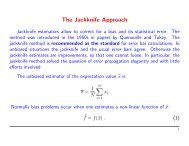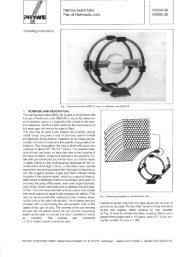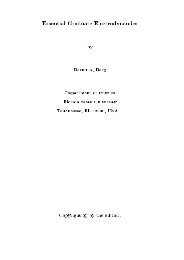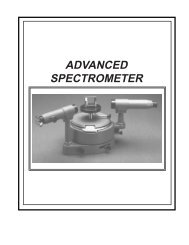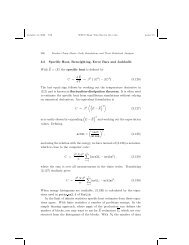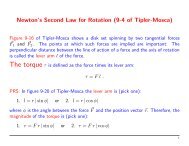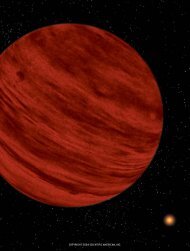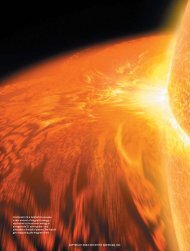Supersoft X-ray Stars and Supernovae - Scientific American Digital
Supersoft X-ray Stars and Supernovae - Scientific American Digital
Supersoft X-ray Stars and Supernovae - Scientific American Digital
You also want an ePaper? Increase the reach of your titles
YUMPU automatically turns print PDFs into web optimized ePapers that Google loves.
<strong>Supersoft</strong> X-<strong>ray</strong> <strong>Stars</strong><br />
Several years ago astronomers came across a new type of star that<br />
spews out unusually low energy x-<strong>ray</strong>s. These so-called supersoft<br />
sources are now thought to be white dwarf stars that cannibalize<br />
their stellar companions <strong>and</strong> then, in many cases, explode<br />
By Peter Kahabka, Edward P. J. van den Heuvel <strong>and</strong> Saul A. Rappaport<br />
DAVID AND GOLIATH STARS form<br />
a symbiotic binary system: a white<br />
dwarf <strong>and</strong> a red giant star in mutual<br />
orbit. The dwarf, with its intense<br />
gravity, is slurping off the outer layers<br />
of the giant. The pilfered gas goes into<br />
an accretion disk around the dwarf <strong>and</strong><br />
eventually settles onto its surface,<br />
whereupon it can ignite nuclear fusion<br />
<strong>and</strong> generate a large quantity of<br />
low-energy x-<strong>ray</strong>s.<br />
COPYRIGHT 2004 SCIENTIFIC AMERICAN, INC.
<strong>and</strong> <strong>Supernovae</strong><br />
Since the 1930s astronomers have known that ordinary stars shine because of nuclear fusion<br />
deep in their interior. In the core of the sun, for example, 600 million tons of hydrogen<br />
fuse into helium every second. This process releases energy in the form of x-<strong>ray</strong>s <strong>and</strong><br />
gamma <strong>ray</strong>s, which slowly wend their way outward through the thick layers of gas. By the time<br />
the radiation reaches the surface of the star, it has degraded into visible light.<br />
Recently, however, researchers have discovered a<br />
new class of stars in which the nuclear fusion takes place<br />
not in the deep interior but in the outer layers just below<br />
the surface. These stars appear to be white dwarfs—<br />
dense, burned-out stars that have exhausted their nuclear<br />
fuel—in orbit around ordinary stars. The dwarfs steal hydrogen<br />
gas from their companions, accumulate it on their<br />
surface <strong>and</strong> resume fusion. The result is a torrent of x-<br />
<strong>ray</strong>s with a distinctive “soft” range of wavelengths; such<br />
stars are known as luminous supersoft x-<strong>ray</strong> sources. As<br />
the dwarfs gain weight, they eventually grow unstable,<br />
at which point they can collapse into an even denser neutron<br />
star or explode.<br />
The disruption of white dwarfs has long been conjectured<br />
as the cause of one sort of supernova explosion,<br />
called type Ia. With the discovery of the supersoft<br />
sources, observers have identified for the first time a class<br />
of star system that can detonate in this way. Type Ia supernovae<br />
have become important as bright “st<strong>and</strong>ard<br />
c<strong>and</strong>les” for measuring distances to faraway galaxies <strong>and</strong><br />
thereby the pace of cosmic expansion. Much of the lingering<br />
uncertainty in estimates of the age <strong>and</strong> the expansion<br />
rate of the universe is connected to astronomers’<br />
ignorance of what gives rise to these<br />
supernovae. <strong>Supersoft</strong> sources may be one of<br />
the long-sought missing links.<br />
The story of the supersoft sources<br />
began with the launch of the German<br />
x-<strong>ray</strong> satellite ROSAT in<br />
1990. This orbiting observatory<br />
carried out the first<br />
complete survey of the<br />
sky in soft x-<strong>ray</strong>s, a form of electromagnetic radiation<br />
that straddles ultraviolet light <strong>and</strong> the better-known<br />
“hard” x-<strong>ray</strong>s. Soft x-<strong>ray</strong>s have wavelengths that are one<br />
thous<strong>and</strong>th to one fiftieth those of visible light—which<br />
means that the energy of their photons (the unit x-<strong>ray</strong> astronomers<br />
prefer to think in) is between about 0.09 <strong>and</strong><br />
2.5 kiloelectron volts (keV). Hard x-<strong>ray</strong>s have energies<br />
up to a few hundred keV. With the exception of the National<br />
Aeronautics <strong>and</strong> Space Administration’s orbiting<br />
Einstein Observatory, which covered the energy range<br />
from 0.2 to 4.0 keV, previous satellites had concentrated<br />
on the hard x-<strong>ray</strong>s.<br />
Almost immediately the ROSAT team, led by Joachim<br />
Trümper of the Max Planck Institute for Extraterrestrial<br />
Physics near Munich, noticed some peculiar objects during<br />
observations of the Large Magellanic Cloud, a small<br />
satellite galaxy of the Milky Way. The objects emitted x-<br />
<strong>ray</strong>s at a prodigious rate—some 5,000 to 20,000 times the<br />
total energy output of our sun—but had an unexpectedly<br />
soft spectrum. Bright x-<strong>ray</strong> sources generally have hard<br />
spectra, with peak energies in the range of 1 to 20 keV,<br />
which are produced by gas at temperatures of 10 million<br />
to 100 million kelvins. These hard x-<strong>ray</strong> sources represent<br />
neutron stars <strong>and</strong> black holes in the process of devouring<br />
their companion stars [see “X-<strong>ray</strong> Binaries,” on page<br />
58]. But the soft spectra of the new stars—with photon<br />
energies a hundredth of those in other bright x-<strong>ray</strong><br />
sources—implied temperatures of only a few hundred<br />
thous<strong>and</strong> kelvins. On an x-<strong>ray</strong> color picture, the objects<br />
appear red, whereas classical, hard x-<strong>ray</strong> sources look<br />
blue [see illustration at bottom left of next page].<br />
The reason the supersoft sources had not been recognized<br />
before as a separate class of star is that the earlier<br />
x-<strong>ray</strong> detectors were less sensitive to low energies. In<br />
fact, after the ROSAT findings, researchers went back<br />
through their archives <strong>and</strong> realized that two of the<br />
sources had been discovered 10 years earlier by Knox S.<br />
Long <strong>and</strong> his colleagues at the Columbia University<br />
Updated from the February 1999 issue 77<br />
COPYRIGHT 2004 SCIENTIFIC AMERICAN, INC.
Wavelength (nanometers)<br />
∞ 2.50 1.25<br />
0.83 0.62 0.50<br />
3 x 10 5 degrees<br />
Inferred<br />
source<br />
spectrum<br />
Detector<br />
efficiency<br />
Detected<br />
spectrum<br />
SUPERSOFT X-RAY SOURCE<br />
HARD X-RAY SOURCE<br />
3 x 10 7 degrees<br />
Detector<br />
efficiency<br />
Inferred<br />
source<br />
spectrum<br />
Detected<br />
spectrum<br />
0 0.5 1.0 1.5 2.0 2.5<br />
Energy (kiloelectron volts)<br />
SOFT AND HARD x-<strong>ray</strong> sources are distinguished by their spectra, as<br />
measured by the ROSAT orbiting observatory. A typical supersoft source<br />
(top) emits x-<strong>ray</strong>s with a fairly low energy, indicative of a comparatively cool<br />
temperature of 300,000 degrees Celsius. A typical hard x-<strong>ray</strong> source (bottom)<br />
is 100 times hotter <strong>and</strong> therefore emits higher-energy x-<strong>ray</strong>s. In both cases,<br />
the intrinsic spectrum of the source (red curves) is distorted by the response<br />
of the ROSAT detector ( g<strong>ray</strong> curves) <strong>and</strong> by interstellar gas absorption.<br />
CAL 87<br />
CAL 83<br />
RXJ0513.9-6951<br />
X-RAY COLOR IMAGE (left) shows how a nearby mini galaxy, the Large<br />
Magellanic Cloud, might appear to someone with x-<strong>ray</strong> vision. A red color<br />
denotes lower-energy (or, equivalently, longer-wavelength) radiation;<br />
blue means higher energy (shorter wavelength). <strong>Supersoft</strong> sources st<strong>and</strong><br />
Astrophysics Laboratory (CAL), using the Einstein Observatory.<br />
These sources, named CAL 83 <strong>and</strong> CAL 87, had not been<br />
classified as distinct from other strong sources in the Large<br />
Magellanic Cloud, although the Columbia team did remark<br />
that their spectra were unusually soft.<br />
Back of the Envelope<br />
AT THE TIME, Anne P. Cowley <strong>and</strong> her co-workers at Arizona<br />
State University surmised that CAL 83 <strong>and</strong> 87 were accreting<br />
black holes, which often have softer spectra than neutron<br />
stars do. This suggestion seemed to receive support in the<br />
1980s, when faint stars were found at the locations of both<br />
sources. The stars’ brightnesses oscillated, a telltale sign of a<br />
binary star system, in which two stars are in mutual orbit. In<br />
1988 an international observing effort led by Alan P. Smale<br />
of University College London found that the brightness of<br />
CAL 83 fluctuated with a period of just over one day. A similar<br />
project led by Tim Naylor, now at the University of Exeter<br />
in Engl<strong>and</strong>, obtained a period of 11 hours for CAL 87.<br />
These visible companion stars are the fuel for the hypothesized<br />
black holes. Assuming they have not yet been decimated, the<br />
various measurements indicated that they weighed 1.2 to 2.5<br />
times as much as the sun.<br />
But the ROSAT observations suddenly made this explanation<br />
very unlikely. The sources were much cooler than any<br />
known black hole system. Moreover, their brightness <strong>and</strong><br />
temperature revealed their size. According to basic physics,<br />
each unit area of a star radiates an amount of energy proportional<br />
to the fourth power of its temperature. By dividing this<br />
energy into the total emission of the star, astronomers can easily<br />
calculate its surface area <strong>and</strong>, assuming it to be spherical,<br />
out as red or orange dots; hard x-<strong>ray</strong> sources look blue. The supersoft star<br />
CAL 87 seems green because a cloud of hydrogen alters its true color.<br />
(Some red dots are actually sunlike stars in the foreground.) The view is<br />
rather different from an ordinary photograph of the area (right).<br />
ALFRED T. KAMAJIAN (preceding pages); BRYAN CHRISTIE; SOURCE: PETER KAHABKA, EDWARD P. J. VAN DEN HEUVEL AND SAUL A. RAPPAPORT (graphs);<br />
WOLFGANG PIETSCH ROSAT Team ( bottom left); SVEN KOHLE University of Bonn ( bottom right)<br />
78 SCIENTIFIC AMERICAN THE SECRET LIVES OF STARS<br />
COPYRIGHT 2004 SCIENTIFIC AMERICAN, INC.
its diameter. It turns out that CAL 83, CAL 87 <strong>and</strong> the other<br />
Magellanic Cloud sources each have a diameter of 10,000 to<br />
20,000 kilometers (16,000 to 32,000 miles)—the size of a<br />
white dwarf star. They are therefore 500 to 1,000 times as<br />
large as a neutron star or the “horizon” at the edge of a stellar-mass<br />
black hole. When Trümper first described the supersoft<br />
sources at a conference at the Santa Barbara Institute for<br />
Theoretical Physics in January 1991, several audience members<br />
quickly made this calculation on the proverbial back of<br />
the envelope.<br />
Some conference participants, among them Jonathan E.<br />
Grindlay of Harvard University, suggested that the sources<br />
were white dwarfs that gave off x-<strong>ray</strong>s as gas crashed onto<br />
their surface—much as hard x-<strong>ray</strong> sources result from the accretion<br />
of matter onto a neutron star or into a black hole. Others,<br />
including Trümper, his colleagues Jochen Greiner <strong>and</strong><br />
Günther Hasinger, <strong>and</strong>, independently, Nikolaos D. Kylafis<br />
<strong>and</strong> Kiriaki M. Xilouris of the University of Crete, proposed<br />
that the sources were neutron stars that had somehow built<br />
up a gaseous blanket some 10,000 kilometers thick. In either<br />
case, the ultimate source of the energy would be gravitational.<br />
Gravity would pull material toward the dwarf or neutron<br />
star, <strong>and</strong> the energy of motion would be converted to heat <strong>and</strong><br />
radiation during collisions onto the stellar surface or within<br />
the gas.<br />
Both models seemed worth detailed study, <strong>and</strong> two of us<br />
(van den Heuvel <strong>and</strong> Rappaport), collaborating with Dipankar<br />
Bhattacharya of the Raman Research Institute in Bangalore,<br />
India, were lucky enough to be able to start such studies<br />
immediately. The conference was part of a half-year workshop<br />
at Santa Barbara, where several dozen scientists from<br />
different countries had the time to work together on problems<br />
related to neutron stars.<br />
It soon became clear that neither model worked. The supersoft<br />
sources emit about the same power as the brightest accreting<br />
neutron stars in binaries. Yet gas collisions onto neutron<br />
stars are 500 to 1,000 times as forceful as the same process<br />
on white dwarfs, because the effect of gravity at the<br />
surface of a neutron star is that much greater. (For bodies of<br />
the same mass, the available gravitational energy is inversely<br />
proportional to the radius of the body.) Thus, for a dwarf to<br />
match the output of a neutron star, it would need to sweep up<br />
material at 500 to 1,000 times the rate. In such a frenetic accretion<br />
flow—equivalent to several Earth masses a year—the<br />
incoming material would be so dense that it would totally absorb<br />
any x-<strong>ray</strong>s.<br />
Neutron stars with gaseous blankets also ran into trouble.<br />
Huge envelopes of gas (huge, that is, with respect to the<br />
10-kilometer radius of the neutron star) would be unstable;<br />
they would either collapse or be blown away in a matter of<br />
seconds or minutes. Yet CAL 83 <strong>and</strong> CAL 87 had been shining<br />
for at least a decade. Indeed, the ionized interstellar gas<br />
nebula surrounding CAL 83 took many tens of thous<strong>and</strong>s of<br />
years to create.<br />
Sun<br />
Escape velocity<br />
600 km/s<br />
Escape velocity<br />
6,000 km/s<br />
White dwarf<br />
White dwarf<br />
Escape velocity<br />
150,000 km/s<br />
Neutron<br />
star<br />
Escape velocity<br />
300,000 km/s<br />
Neutron<br />
star<br />
Escape velocity<br />
11 km/s<br />
20 km<br />
Stellar<br />
black hole<br />
20 km<br />
Earth<br />
ALFRED T. KAMAJIAN<br />
13,000 km<br />
COMPACT STARS have colossal escape velocities. A typical white dwarf<br />
(left) packs the mass of the sun into the volume of a planet. To break free<br />
of its gravity, an object must travel at some 6,000 kilometers per second.<br />
This is also about the speed that a body doing the reverse trip—falling onto<br />
the dwarf from afar—would have on impact. Denser stars, such as neutron<br />
stars with the same mass (center), have an even mightier grip. The<br />
densest possible star, a black hole, is defined by a “horizon” from which<br />
the escape velocity equals the speed of light (right).<br />
Nuclear Power<br />
AFTER WEEKS OF DISCUSSING <strong>and</strong> evaluating models,<br />
none of which worked, astrophysicists realized the crucial difference<br />
between accretion of material onto neutron stars or<br />
black holes <strong>and</strong> accretion onto white dwarfs. The former generates<br />
much more energy than nuclear fusion of the same<br />
amount of hydrogen, whereas the latter produces much less enwww.sciam.com<br />
SCIENTIFIC AMERICAN 79<br />
COPYRIGHT 2004 SCIENTIFIC AMERICAN, INC.
16.5<br />
Visual Brightness<br />
(magnitude)<br />
17.0<br />
17.5<br />
X-Ray Brightness<br />
(counts per second)<br />
10 –2<br />
10 –3<br />
Oct. 24,<br />
1994<br />
Dec. 13,<br />
1994<br />
Feb. 1,<br />
1995<br />
March 23,<br />
1995<br />
Oct. 24,<br />
1994<br />
Dec. 13,<br />
1994<br />
Feb. 1,<br />
1995<br />
March 23,<br />
1995<br />
ON/OFF EMISSION of supersoft star RXJ0513.9-6951 is a sign that it is<br />
poised between two different modes of behavior. When it shines brightly<br />
in visible light (left graph), its x-<strong>ray</strong> output (right graph) is low, <strong>and</strong> vice<br />
versa. (The lower x-<strong>ray</strong> counts are upper limits.) The star is at the border<br />
LIFE CYCLE of a supersoft star (sequence 1–6, on opposite page) begins<br />
with an unequal binary star system <strong>and</strong> ends with a type Ia supernova<br />
explosion. The supersoft phase can take one of three forms, depending on<br />
the companion star. If it is an ordinary star in a tight orbit, it can overflow<br />
its Roche lobe <strong>and</strong> cede control of its outer layers to the white dwarf (5a,<br />
on opposite page). If the companion is a red giant star of sufficient size, it<br />
also overflows its Roche lobe (5b, at right). Finally, if it is a red giant with a<br />
smaller size or a wider orbit, it can power a supersoft source with its strong<br />
winds (5c, on opposite page). Not all supersoft sources blow up, but<br />
enough do to account for the observed rate of supernovae.<br />
10 –1 Roche lobe<br />
between a pure supersoft source (which would emit only x-<strong>ray</strong>s) <strong>and</strong><br />
a white dwarf surrounded by thick gas (which would emit only visible<br />
light). Slight fluctuations in the rate of gas intake switch the star<br />
from one behavior to the other.<br />
ergy than fusion. Of the energy inherent in mass (Albert Einstein’s<br />
famous E = mc 2 ), fusion releases 0.7 percent. Accretion<br />
onto a neutron star, however, liberates more than 10 percent;<br />
into a black hole, up to 46 percent before the material disappears<br />
completely. On the other h<strong>and</strong>, accretion onto a white<br />
dwarf, with its comparatively weak gravity, liberates only<br />
about 0.01 percent of the inherent energy.<br />
Therefore, on white dwarfs, nuclear fusion is potentially<br />
more potent than accretion. If hydrogen accumulated on the<br />
surface of a white dwarf <strong>and</strong> somehow started to “burn” (that<br />
is, undergo fusion), only about 0.03 Earth mass would be<br />
needed a year to generate the observed soft x-<strong>ray</strong> luminosity.<br />
Because of the lower density of inflowing matter, the x-<strong>ray</strong>s<br />
would be able to escape.<br />
Stable nuclear burning of inflowing matter would account<br />
for the paradoxical brightness of the supersoft sources. But is<br />
it really possible Here we were lucky. Just when we were discussing<br />
this issue, Ken’ichi Nomoto of the University of Tokyo<br />
arrived in Santa Barbara. He had already been trying to answer<br />
the very same question in order to underst<strong>and</strong> another<br />
phenomenon, nova explosions—outbursts much less energetic<br />
than supernovae that cause a star suddenly to brighten<br />
10,000-fold but do not destroy it. Novae always occur in close<br />
binaries that consist of a white dwarf <strong>and</strong> a sunlike star. Until<br />
the discovery of supersoft sources, they were the only<br />
known close binaries.<br />
For over a decade, Nomoto <strong>and</strong> others had been improving<br />
on the pioneering simulations by Bohdan Paczynski <strong>and</strong><br />
Anna Zytkow, both then at the Nicolaus Copernicus Astronomical<br />
Center in Warsaw. According to these analyses, hydrogen<br />
that has settled onto the surface of a dwarf can indeed<br />
burn. The style of burning depends on the rate of accretion.<br />
If it is sufficiently low, below 0.003 Earth mass a year, fusion<br />
is spasmodic. The newly acquired hydrogen remains passive,<br />
often for thous<strong>and</strong>s of years, until its accumulated mass exceeds<br />
a critical value, at which point fusion is abruptly ignited<br />
at its base. The ensuing thermonuclear explosion is visible<br />
as a nova.<br />
If the accretion rate is slightly higher, fusion is cyclic but<br />
not explosive. As the rate increases, the interval between burning<br />
cycles becomes shorter <strong>and</strong> shorter, <strong>and</strong> above a certain<br />
threshold value, stable burning sets in. For white dwarfs of<br />
one solar mass, this threshold is about 0.03 Earth mass a year.<br />
In the simulations, fusion generates exactly the soft x-<strong>ray</strong> luminosity<br />
observed in the supersoft sources.<br />
5b<br />
BRYAN CHRISTIE; SOURCE: KLAUS REINSCH University of Göttingen ( left)<br />
AND STEFAN G. SCHAEIDT Max Planck Institute for Extraterrestrial Physics ( right)<br />
80 SCIENTIFIC AMERICAN THE SECRET LIVES OF STARS<br />
COPYRIGHT 2004 SCIENTIFIC AMERICAN, INC.
If the rate is still higher, above 0.12 Earth mass a year, the<br />
incoming gas does not settle onto the surface but instead forms<br />
an extended envelope around the dwarf. Steady burning continues<br />
on the surface, but the thick envelope degrades the x-<br />
<strong>ray</strong>s into ultraviolet <strong>and</strong> visible light. Recent calculations have<br />
shown that the radiation is so intense that it exerts an outward<br />
pressure on gas in the envelope, causing part of it to stream<br />
away from the star in a stellar wind.<br />
If the accretion rate hovers around 0.12 Earth mass a year,<br />
the system may alternate between x-<strong>ray</strong> <strong>and</strong> visible phases.<br />
Exactly this type of behavior has been found in the supersoft<br />
source known as RXJ0513.9-6951, which was discovered by<br />
Stefan G. Schaeidt of the Max Planck institute. It gives off x-<br />
<strong>ray</strong>s for weeks at a time, with breaks of several months. This<br />
on/off emission puzzled astronomers until 1996, when Karen<br />
A. Southwell <strong>and</strong> her colleagues at the University of Oxford<br />
noticed that the visible counterpart to this star fluctuated, too.<br />
When the visible star is faint, the x-<strong>ray</strong> source is bright, <strong>and</strong><br />
vice versa [see top illustration on opposite page]. The system<br />
also features two high-speed jets of matter flowing out in opposite<br />
directions at an estimated 4,000 to 6,000 kilometers<br />
per second. Such jets are common where an accretion disk<br />
dumps more material on the star than it can absorb. The excess<br />
squirts out in a direction perpendicular to the disk, where<br />
there is no inflowing matter to block it. The outflow velocity<br />
is expected to be approximately the same as the escape velocity<br />
from the surface of the star. In RXJ0513.9-6951 the inferred<br />
speed nearly equals the escape velocity from a white<br />
dwarf—further confirmation that the supersoft sources are<br />
white dwarfs.<br />
1 2 3 4 5a<br />
6<br />
BRYAN CHRISTIE<br />
Pair of ordinary<br />
stars burn hydrogen<br />
in their cores<br />
One exhausts fuel<br />
in core, becomes<br />
red giant<br />
Orbit tightens;<br />
giant envelops<br />
other star<br />
Giant sheds outer<br />
layers, becomes<br />
white dwarf<br />
Dwarf steals gas<br />
from other star,<br />
emits soft x-<strong>ray</strong>s<br />
Dwarf reaches<br />
critical mass,<br />
explodes<br />
5c<br />
White dwarf<br />
Accretion disk<br />
ALFRED T. KAMAJIAN<br />
Companion star<br />
Stellar wind<br />
ALFRED T. KAMAJIAN<br />
Soft-Boiled Star<br />
NOT EVERY BINARY SYSTEM can supply material at the<br />
rates required to produce a supersoft source. If the companion<br />
star is less massive than the white dwarf, as is typically observed<br />
in nova-producing systems, the fastest that material can<br />
flow in is 0.0003 Earth mass a year. This limit is a consequence<br />
of the law of conservation of orbital angular momentum. As<br />
the small companion star loses mass, its orbit widens <strong>and</strong> the<br />
flow rate stabilizes.<br />
For the rates to be higher, the donor star must have a mass<br />
greater than that of the dwarf. Then the conservation of angular<br />
momentum causes the orbit to shrink as a result of the<br />
mass transfer. The stars come so close that they begin a graviwww.sciam.com<br />
SCIENTIFIC AMERICAN 81<br />
COPYRIGHT 2004 SCIENTIFIC AMERICAN, INC.
0.3<br />
STEADY BURNING, GASEOUS ENVELOPE AND<br />
WIND FORM<br />
Accretion Rate (Earth masses a year)<br />
0.03<br />
0.003<br />
STEADY BURNING<br />
(SUPERSOFT SOURCES)<br />
CYCLIC, NONEXPLOSIVE BURNING<br />
CYCLIC, EXPLOSIVE BURNING<br />
(NOVAE)<br />
0.6 0.8 1.0 1.2 1.4<br />
White Dwarf Mass (solar masses)<br />
STYLE OF NUCLEAR FUSION on the surface of a white dwarf depends on how<br />
massive the dwarf is <strong>and</strong> how fast it is devouring its companion star (vertical<br />
axis). If the accretion rate is sufficiently low, fusion (which astronomers<br />
tational tug-of-war for control of the outer layers of the donor.<br />
Material within a certain volume called the Roche lobe remains<br />
under the sway of the donor’s gravity, while material beyond<br />
it is stripped off by the dwarf. Perversely, the donor abets its<br />
own destruction. While it sheds mass at the surface, the<br />
amount of energy generated by fusion in the core remains<br />
largely unaffected. The continued heating from below exerts<br />
pressure on the outer layers to maintain the original shape of<br />
the star. This pressure replenishes the material ripped off the<br />
dwarf, much as an overflowing pot of soup on a hot burner will<br />
continue to pour scalding water onto the stove. The situation<br />
stabilizes only when the effects of mass loss are felt by the core<br />
itself. For a star originally of two solar masses, the return to<br />
equilibrium—<strong>and</strong> thus the cessation of supersoft emission—<br />
takes seven million years after the onset of plundering. By this<br />
time the star has shrunk to a fifth of its initial mass <strong>and</strong> become<br />
the lesser star in the system. The average accretion rate onto<br />
the dwarf in such a case is about 0.04 Earth mass a year.<br />
Following this reasoning, we predicted in 1991 that<br />
many supersoft sources would be white dwarfs in tight orbits<br />
(with periods of less than a few days) around a companion<br />
star whose original mass was 1.2 to 2.5 solar masses. In fact,<br />
CAL 83 <strong>and</strong> 87 are precisely such systems. Since 1992 orbital<br />
periods for four more supersoft sources have been measured;<br />
all periods were less than a few days. The explanation may<br />
also apply to a class of novalike binary systems, called V Sagittae<br />
stars, whose oscillating brightness has perplexed astronomers<br />
for a century. In 1998 Joseph Patterson of Columbia<br />
<strong>and</strong> his collaborators <strong>and</strong>, independently, Joao E. Steiner<br />
<strong>and</strong> Marcos P. Diaz of the National Astrophysical Laboratory<br />
in Itajubá, Brazil, demonstrated that the prototype of<br />
misleadingly call “burning”) occurs in spurts, either gently or explosively.<br />
Otherwise it is continuous. As shown above, phenomena once thought to<br />
be distinct—such as novae <strong>and</strong> supersoft sources—are closely related.<br />
this class of stars has the appropriate mass <strong>and</strong> orbital period.<br />
There is one other group of star systems that could give<br />
rise to supersoft sources: so-called symbiotic binaries, in which<br />
the white dwarf is in a wide orbit about a red giant star. Red<br />
giants are willing donors. Bloated by age, they have relatively<br />
weak surface gravity <strong>and</strong> already discharge matter in strong<br />
stellar winds. In 1994 one of us (Kahabka), Hasinger <strong>and</strong><br />
Wolfgang Pietsch of the Max Planck Institute discovered a supersoft<br />
symbiotic binary in the Small Magellanic Cloud, another<br />
satellite galaxy of the Milky Way. Since then, a further<br />
half dozen such sources have been found.<br />
Some supersoft sources are harder to recognize because their<br />
accretion rate varies with time. One source in our galaxy alternates<br />
between x-<strong>ray</strong> <strong>and</strong> visible emission on a cycle of 40 years,<br />
as seen on archival photographic plates. A few objects, such as<br />
Nova Muscae 1983 <strong>and</strong> Nova Cygni 1992, combine nova be-<br />
THE AUTHORS<br />
PETER KAHABKA, EDWARD P. J. VAN DEN HEUVEL <strong>and</strong> SAUL A.<br />
RAPPAPORT never thought supersoft sources would be explained<br />
by white dwarfs. That insight came about during a workshop that<br />
van den Heuvel <strong>and</strong> Rappaport organized on a different topic: neutron<br />
stars. Two years later these veteran astronomers met Kahabka,<br />
who had discovered many supersoft sources as a member<br />
of the ROSAT team. Today Kahabka is research associate at the<br />
University of Bonn in Germany. Van den Heuvel is director of the<br />
Astronomical Institute at the University of Amsterdam <strong>and</strong> the<br />
1995 recipient of the Spinoza Award, the highest science award<br />
in the Netherl<strong>and</strong>s. An amateur archaeologist, he owns an extensive<br />
collection of early Stone Age tools. Rappaport is a physics<br />
professor at the Massachusetts Institute of Technology. He was<br />
one of the pioneers of x-<strong>ray</strong> astronomy in the 1970s.<br />
BRYAN CHRISTIE; SOURCE: ICKO IBEN University of Illinois<br />
82 SCIENTIFIC AMERICAN THE SECRET LIVES OF STARS<br />
COPYRIGHT 2004 SCIENTIFIC AMERICAN, INC.
havior with supersoft emission, which can be explained by a<br />
years-long period of sedate “afterburning” between eruptions.<br />
The Seeds of <strong>Supernovae</strong><br />
THE COMPANION MASSES required of supersoft sources<br />
with short orbital periods imply that they are relatively young<br />
systems (compared with the age of our galaxy). <strong>Stars</strong> of the<br />
inferred mass live at most a few billion years <strong>and</strong> are always located<br />
in or near the youthful central plane of the galaxy. Unfortunately,<br />
that location puts them in the region thick with interstellar<br />
clouds, which block soft x-<strong>ray</strong>s. For this reason, the<br />
observed population is only the tip of the iceberg. Extrapolating<br />
from the known number of supersoft sources, we have estimated<br />
that the total number in our galaxy at any one time is<br />
several thous<strong>and</strong>. A few new ones are born every 1,000 years,<br />
<strong>and</strong> a few others die.<br />
What happens as they pass away The fusion of matter received<br />
from the companion clearly causes the white dwarf to<br />
Nuclear burning of inflowing matter<br />
WOULD ACCOUNT FOR THE PARADOXICAL BRIGHTNESS<br />
of the supersoft sources. But is it really possible<br />
grow in mass. It could reach the Ch<strong>and</strong>rasekhar limit of about<br />
1.4 solar masses, the maximum mass a white dwarf can have.<br />
Beyond this limit, the quantum forces that hold up the dwarf<br />
falter. Depending on the initial composition <strong>and</strong> mass of the<br />
dwarf, there are two possible outcomes: collapse to a neutron<br />
star or destruction in a nuclear fireball. Dwarfs that either lack<br />
carbon or are initially larger than 1.1 solar masses collapse. A<br />
number of theorists have analyzed this fate.<br />
White dwarfs that do not meet either of these criteria simply<br />
blow up. They may slowly amass helium until they reach<br />
the Ch<strong>and</strong>rasekhar limit <strong>and</strong> explode. Alternatively, the helium<br />
layer may reach a critical mass prematurely <strong>and</strong> ignite<br />
itself explosively. In the latter case, shock waves convulse the<br />
star <strong>and</strong> ignite the carbon at its core. And once the carbon<br />
burning begins, it becomes a runaway process in the dense,<br />
taut material of the dwarf. Within a few seconds the star is<br />
converted largely into nickel as well as other elements between<br />
silicon <strong>and</strong> iron. The nickel, dispersed into space, radioactively<br />
decays to cobalt <strong>and</strong> then iron in a few hundred<br />
days. Astronomers had already ascribed a kind of explosion<br />
to the death of carbon-rich dwarfs—the supernova type Ia.<br />
The spectrum of such a supernova lacks any sign of hydrogen<br />
or helium, one of the factors that distinguish it from the<br />
other types of supernovae (Ib, Ic <strong>and</strong> II), which all probably<br />
result from the implosion <strong>and</strong> subsequent explosion of massive<br />
stars. Type Ia supernovae are thought to be a major<br />
source of iron <strong>and</strong> related elements throughout the universe,<br />
including on Earth. Four occur every 1,000 years on average<br />
in a galaxy such as the Milky Way.<br />
Before supersoft sources were discovered, astronomers<br />
were unsure as to the precise sequence that led to type Ia supernovae.<br />
The leading explanations implicated either certain<br />
symbiotic stars—in particular, the rare recurrent novae—or<br />
mergers of two carbon-rich white dwarfs. But the latter view<br />
is now disputed. Although recently double-dwarf systems<br />
with the necessary mass <strong>and</strong> orbital period have been discovered,<br />
calculations by Nomoto <strong>and</strong> his colleague Hadeyuki<br />
Saio have shown that such a merger could in many cases be<br />
too gentle to produce a thermonuclear explosion <strong>and</strong> instead<br />
would lead to the formation of a neutron star. <strong>Supersoft</strong><br />
sources <strong>and</strong> other surface-burning dwarfs seem a good alternative<br />
solution. Their death rate roughly matches the observed<br />
supernova frequency. The concordance makes the luminous<br />
supersoft binary x-<strong>ray</strong> sources the first firmly identified class<br />
of objects that can realistically be expected to end their lives<br />
as type Ia supernovae.<br />
This new realization may improve the accuracy of cosmological<br />
measurements that rely on these supernovae to determine<br />
distance [see “Surveying Space-time with <strong>Supernovae</strong>,”<br />
by Craig J. Hogan, Robert P. Kirshner <strong>and</strong> Nicholas B.<br />
Suntzeff; <strong>Scientific</strong> <strong>American</strong>, January 1999]. Subtle variations<br />
in brightness can make all the difference between conflicting<br />
conclusions concerning the origin <strong>and</strong> fate of the universe.<br />
The worry for cosmologists has always been that slight systematic<br />
errors—the product, perhaps, of astronomers’ incomplete<br />
underst<strong>and</strong>ing of the stars that go supernova—could<br />
mimic real variations. The implications of the supersoft findings<br />
for cosmology, however, have yet to be worked out.<br />
When supersoft sources were first detected, nobody expected<br />
that the research they provoked would end up uniting<br />
so many phenomena into a single coherent theory. Now it is<br />
clear that a once bewildering assortment of variable stars, novae<br />
<strong>and</strong> supernovae are all variants on the same basic system:<br />
an ordinary star in orbit around a reanimated white dwarf.<br />
The universe seems that much more comprehensible.<br />
MORE TO EXPLORE<br />
Luminous <strong>Supersoft</strong> X-<strong>ray</strong> Sources. P. Kahabka <strong>and</strong> E.P.J. van den<br />
Heuvel in Annual Review of Astronomy <strong>and</strong> Astrophysics, Vol. 35, pages<br />
69–100. Annual Reviews, 1997.<br />
SNeIa: On the Binary Progenitors <strong>and</strong> Expected Statistics. Pilar Ruiz-<br />
Lapuente, Ramon Canal <strong>and</strong> Andreas Burkert in Thermonuclear<br />
<strong>Supernovae</strong>. Edited by Ramon Canal, Pilar Ruiz-Lapuente <strong>and</strong> Jordi Isern.<br />
Kluwer, 1997. Preprint available at xxx.lanl.gov/abs/astro-ph/9609078<br />
Type Ia <strong>Supernovae</strong>: Their Origin <strong>and</strong> Possible Applications in<br />
Cosmology. Ken’ichi Nomoto, Koichi Iwamoto <strong>and</strong> Nobuhiro Kishimoto in<br />
Science, Vol. 276, pages 1378–1382; May 30, 1997. Preprint available at<br />
xxx.lanl.gov/abs/astro-ph/9706007<br />
www.sciam.com SCIENTIFIC AMERICAN 83<br />
COPYRIGHT 2004 SCIENTIFIC AMERICAN, INC.



